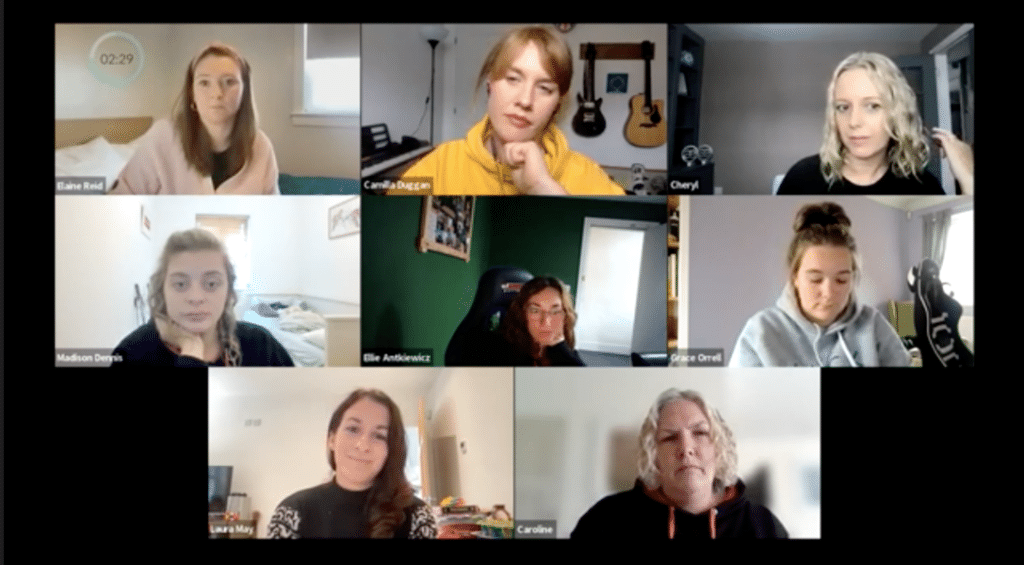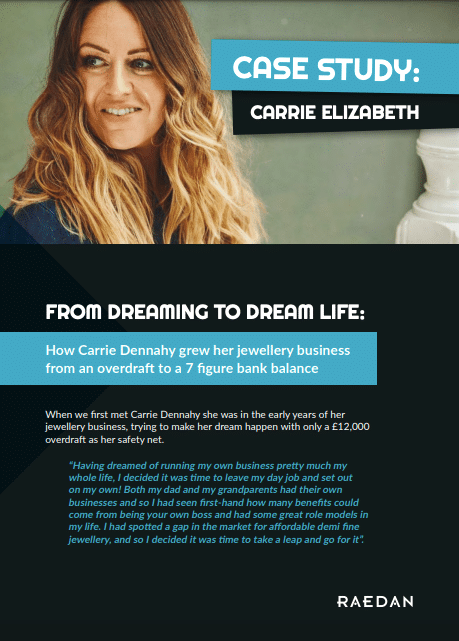
A case study is a powerful way to prove to your ideal clients you have the skills to solve their problems. When you share case studies on your website, on social media, in prospect calls and follow-up emails, your ideal clients get to live vicariously through the experience of someone who was once where they are. But crafting a full case study is a big job, and it takes collaboration.
Telling a client story in detail requires preparation and effort. You might already be put off by case studies because they feel like a big undertaking, and you’re unsure:
- Which client story to tell
- Where to get all the content from
- How to present it and share it so people read it
If you’ve never written a case study, or have limited experience, I’m going to break it down into steps. That way you can take it one stage at a time, and enjoy the process, rather than postponing because you don’t know where to begin. Even better, I’m going to explain why it’s important (no, crucial!) to get your team involved. A case study is a group effort, involving everyone who has worked with the client in your story, and I have outlined why in the stages below.
Shift your mentality from from ‘case study’ to ‘client story’
Historically, and in many industries, a case study has been a very analytical study of an outcome. Lots of data, lots of self-promotion, lots of evidence being shown. In our article on how sharing stories helps you build trust with your audience, we explain that stories are important for your marketing because they show your audience they’re not alone in their experiences. We all want to feel seen, heard and understood. To know others feel the same things we feel and struggle with the same struggles. That’s true whether you’re writing a case study, a blog, or a good LinkedIn post.
Think of a case study as a success story about your client, with you (and your firm and your services) as the supporting act. Your client is the hero and you are the guide.
Think about the last time you invested in support or learning – a course, a coach, outsourced support. What did you want to know about it?
Six months ago I signed up for 1:1 coaching with an ultra marathon training expert. It would be a monthly investment in the pursuit of a specific goal. When doing my research (as we all do) I read lots of blogs she had written and cruised Instagram. I watched any videos I could. But mostly, I paid attention to the runners she had coached. I looked at what their goals were, and what their experience had been on the journey to achieving them.
A case study could have told me:
- All the services my coach had provided for a client
- All her accolades and how experienced she is at providing her services
- Her clients’ final race results
But there would be a large gap in the story – the experience. I didn’t want to know only whether someone had crossed their finish line. I wanted to know:
- Would coaching truly fit around any lifestyle?
- What would happen when life gets in the way?
- What would happen if you didn’t hit your targets?
- What did realistic goals look like?
- How would it feel to have a structure to rely on?
- Did anyone else feel nervous about the initial running assessment?
And so on, and so on…
The accolades weren’t important to me at the time. The stories and experiences from women like me were what tipped me over into a sale.
Your guide to collaboratively creating a case study with your team, in 6 steps.
Step 1: Choose your story
In my experience of running storytelling sessions with accountants, I’ve found many of you don’t feel you have great stories to tell, at first. Skip to the end of the session and we have a whole document full of client success stories ready to be turned into case studies, blogs and videos.
You do have stories. Lots of really powerful ones.
You’re creating a case study because it will bring you the right kind of clients buying the right kind of services. So what story needs to be told?
Do you have:
- A client you’d love to clone? Pick a client you’d like more of, and tell their story. Want to appeal to more ambitious design studios struggling through their first 3 years of business? Create a case study about an ambitious design studio owner you’ve worked with.
- A problem or challenge you see come up often? Do lots of prospects come to you needing a clean up of their books before they can really visualise their goals? Create a case study about a client you’ve moved through this service.
- An incredible transformation? A client who has been through the whole journey with you and seen amazing growth and results. We love a before and after!
Step 2: Run a storytelling session with your team to share stories you have about your clients. Then choose one.
We can facilitate a storytelling session for you. In this session we invite you and your whole team, or a pre-chosen selection of your team, to share your stories with us. With prep and guidance beforehand, we ask each of your team to share a client or team story, allowing you to talk it out as we document it. After the session, we’ll share with you the bank of stories we collected so you have all the material you can use in your marketing. To explore what a storytelling session could deliver for you, drop a note to your Client Marketing Manager or fill in this diagnostic.

Step 3: Complete the core elements of the story
Now you’ve chosen your client, it’s time to put down some details about their experience. Lay the building blocks of a great story.
This case study template helps you do that. This is useful for thinking beyond just company + results. It’ll help you consider the thoughts and feelings and the highs and lows the person experienced.
Remember, you want your reader to think “I get it. I feel like they felt. I want the results they got”.
As the firm owner, you may not have been frontline support for the client. And, as the owner, you will know a client’s success story rarely involves just one member of the team. In fact, a client journey usually involves multiple points of contact. It’s the combination of your unique service and team that makes a client’s experience successful. This is why a collaborative case study is so useful, you gain insight from all angles.
When you write a case study with minimal involvement from the people who actually worked with the client, you miss out on authenticity. The realness. You miss out on the best parts. Worst of all, consumers can smell inauthenticity a mile off. If you write confidently about something you weren’t directly involved in, or worse, you rewrite their story, you run the risk of breaking trust. It will be all the more difficult to build connection because your reader will be questioning your objective. Use the case study template to glean information from your team about the client’s experience and get the whole story from all different perspectives. It’s immensely valuable to utilise the experience of your team.
Some other ways you can use this template:
- As a guide to interview your client one-on-one, and hear about their experience first hand
- Sometimes the accountants we work with prefer that we interview their client, so someone a little further removed from the project can ask good questions objectively
- Likewise, you could have someone else on your team do the interviewing. With the client’s permission, you could even record that interview and use snippets of it within your case study!
Step 4: Write up the story
Now you have all the elements, write a first draft of your case study. Follow the order of the template:
- Tell us who the story is about
- What problem did they have? How was it making them feel?
- What stopped them from solving the problem on their own?
- Why did they come to you, specifically?
- What did you do first? Why? How does this fit within your process?
- What changed or resolved for them, and how did they feel about it?
- What did you do next? Why? How long did that take? What went wrong/right?
- What was the end result?
When it comes to writing a first draft, I’m an advocate for waffling. Get the story down first, because you can always go back and cut words, add numbers and testimonials later.
When it comes to editing, whether it be case studies, blogs or guides, there are few tips to keep all your writing skimmable and powerful:
- Keep sentences short by getting to the point quickly. Waffle as much as you need to in your first draft and then cut, cut, cut. If you can simplify a sentence, do so.
- Keep paragraphs short; 2-3 sentences per paragraph
- Use big bold headers to break up text
- Organise parts of your story into numbered lists and bullet points where you can
But what if I’m not a good writer…?
If writing really isn’t within your comfort zone, assemble your support. With the template filled in, you already have your core story. You’ve done the grunt work and maybe there’s someone else on your team who enjoys writing. Ask for help from the PF team – we support our clients all the way through a case study, from interview through to writing, designing and publishing.
Step 5: Use visuals to grab your reader’s attention
Although a case study tells a story, it doesn’t have to be all words. You could incorporate design into your case study by:
- Including photos that relate to the story – your clients and their people, services or products.
- Including designed images to give impact to the memorable moments – icons and graphics that show concepts and tell the story visually.
- Turning it into a branded PDF – including your brand colours and imagery.
Remember I said show, don’t tell how great you are? Good design helps show your reader:
- How much you care about your clients. You could include real images of your client and their business like Raedan did with this case study about Carrie Elizabeth.
- The value of your brand. 75% of consumers admit to making judgments on a company’s credibility based on the company’s website design (source). Show your brand is high value by including high quality design alongside your content.
- You understand your audience and their problems. Stories make us FEEL something, and good design strengthens the message in the content and leaves little to the imagination. Less ambiguity, more feeling.

But, I’m not a graphic designer…?
There are some things you could do in Canva, but it’s okay if you don’t want to spend your time learning how to design things. And it’s why PF exists – so you can have the beauty of an in-house marketing team…without having one yet.
With a good graphic designer on your side, the sky’s the limit when it comes to sharing impactful client stories. Images, illustrations, motion graphics, animation… There are many design elements you can use to strengthen your message and build a connection with your prospects.
Step 6: Hear from the clients themselves
Before sharing your case study with the world, you’re going to want to share it with the client first. Send a private link to the client for their approval. Make sure they’ve approved it in writing.
When you do that, if appropriate, ask your client if they’d be willing to record a quick video about their experience. Video is the most powerful way for your audience to connect with this person as a human and to feel like they felt (and want the results they got). Just ask for a quick 3-4 minute video recorded on their phone and shared via Google Drive or Dropbox. You could even send them the draft case study so they have talking points.
If your client doesn’t want a video of them to go public, you might:
- Suggest they record a video just for you, so (with their permission) you can share some quotes verbatim in the case study.
- Send them some questions from the case study template so they can share their perspective.
The addition of real client words will add the extra social proof your audience is looking for. Better than saying “we’re the best accountants for you”, your client’s words will show it.
When creating a case study, play to your team’s strengths
Remember: you and your team have first-hand experience of helping your clients define their goals and work through challenges. You are the best people to tell their success story.
You can involve different team members in creating your case studies based on their strengths and passions. The person who worked closest with the client could get their input. You could have the team member who loves podcasts interview the team and get all the details. The person who enjoys writing could create the first draft. It doesn’t all have to fall on your shoulders.
PF can be part of your team too. We combine the golden trio of strategy, content and design to create powerful case studies for you and help you figure out how they fit into the rest of your marketing. Drop a note to your Client Marketing Manager or fill out this diagnostic form to see what a collaboration could look like.
